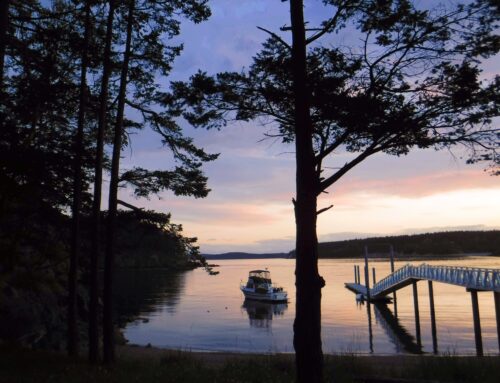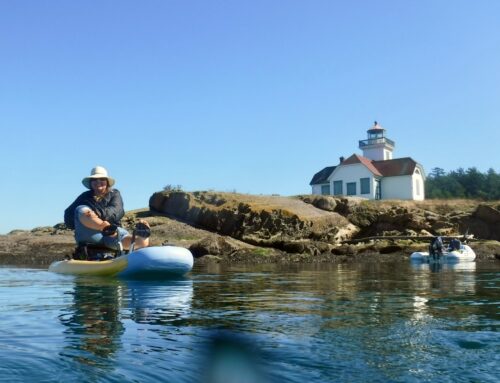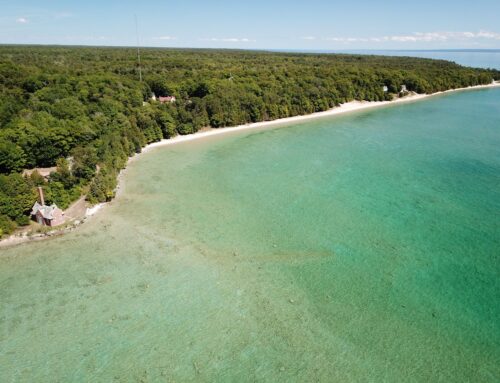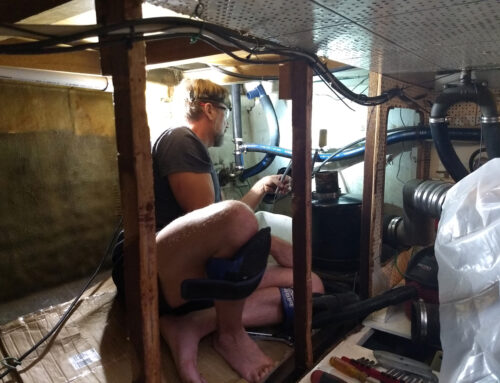Our current marina is located inside of an estuary. Filled with mangroves and even some crocodiles, the water has a visibility of about zero. It’s muddy and coconuts and other debris float by with the tide. Sometimes the coconuts knock against the hull and more than once have we thought somebody was coming to visit.
Camille gets pretty bad “ring around the tub” – what we call it when the white part above the waterline gets brown – and grows a lawn of marine freeloaders on her underbelly. All of this is not good for her gelcoat and fiberglass. If left too long it can leave permanent damage.
When at anchor in clean water, we usually scrub our own bottom (the part of Camille that is underwater) to remove marine growth. But in this water we let the professionals come out and scrub her up. At a dollar a foot it’s really not a bad deal. Guillermo comes out with his team of helpers and the three of them get to scrubbing, scraping and poking for about an hour.
The divers also inspect the sacrificial anodes (commonly known as zincs because that is the material they are made of) and replace them as needed. Good zincs are very important because they work by dissolving (or sacrificing) themselves, before the piece of metal that they are attached to does due to galvanic corrosion. We have zincs attached to the propeller shaft and the strut which holds the propeller shaft.
We don’t have much of a schedule for getting the bottom cleaned – just whenever the ring around the tub gets too ugly. How often do you clean your bottom? Do you have a set schedule or just wait until it needs to get cleaned?
 |
| Divers leave their dive tanks on the dock and use long hoses to breathe so they have better mobility. |
 |
| Removing the ring around the tub |








If you ever need to get rid of the bathtub ring, put some cheap lemon juice in a spray bottle and spray it from the deck. Let it soak for a few and rinse it off. Works like a charm.
Deb
S/V Kintala
http://www.theretirementproject.blogspot.com
Thanks Deb! I wonder what would do to our wax? We’re pretty picky about keeping a god layer of wax on the boat – one of the reasons the brown stuff wipes right off.
I have a blog scheduled regarding this topic too! We have our bottom cleaned regularly here in Fort Lauderdale @ $2 a foot. It’s cheap insurance and peace of mind. If we were somewhere tropical like let’s say Bahamas, or even The Keys, we would do it ourselves, but some jobs are better left to the professionals!
Yikes! You pay twice as much! Glad we’re in Mexico! 🙂
Just visiting, friends, so pardon my ignorance…but are you paying those guys to scrub ablative, copper-infused bottom paint clean?? Up here, that’s illegal and considered unhealthy for all concerned, not just the unwanted critters. Is there a different law/ethic amongst folks sailing in other countries/other waters?
Just asking.
Scott
Lopez Island, WA
Hi Scott, Great question! All they are doing is scraping off the growth, not the paint. In these warm waters we get an inch thick carpet in less than a month. Since our boat’s bottom was last done in California in 2010 we do have bottom paint with copper. By the way, there are still a lot of boats in WA that have copper paint and getting it cleaned regularly. Check out this article and note that the ban hasn’t taken effect yet and only applies to recreational boats: http://threesheetsnw.com/blog/2011/03/bill-to-ban-copper-bottom-paint-passes-senate/
Seeing there are Crocs in the water, I’d say a buck a foot is really cheep!!!!
Exactly what I thought! 🙂